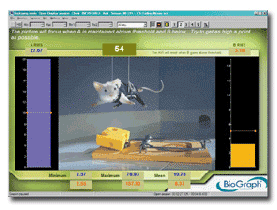![muscle-rehab[1] muscle-rehab[1]](https://www.currenttechnologyinc.com/wp-content/uploads/2020/11/muscle-rehab1.jpg)

The Rehab Suite works with the MyoTrac3 and the MyoTrac Infiniti Clinical Systems. The Rehab Suite was designed by and for physical therapists and includes a clinical guide, explaining the general concepts of each modality.
The Rehab Suite proposes various SEMG assessment and training protocols for Incontinence and Muscle Rehabilitation. The Suite includes very helpful guidelines for beginners, as well as experts.
It combines dynamic graphics, with analysis and reporting functions, the result of 30 years of experience in Biofeedback.
Setup time has never been faster!
- Click on the ‘Start Session’ icon
- Choose your patient
- Choose the training screens (See Recording Options and Protocols)
- Start treatment!
For subsequent training sessions, the patient’s screens and other settings are loaded from the prior session
Audio Visuals Can Make A World of Difference
Comprehensive use of animations and sounds provide relevant rehabilitation goals and activities to keep patients motivated at the highest level:
- Single and dual channel line graphs, bar graphs and digital displays.
- Spectral displays Median frequency for muscle fatigue assessment
- Above and below threshold sound feedback options
- A wide variety of sounds and music
- Animations
- Video
- Templates include a range of simple to challenging visual traces for your patients to follow.
The Suite comes with a number of pre-made templates - or you can create your own!
TRAINING SCREENS FOR:
- Relaxation
- Strengthening
- Control
- Equilibration
PROTOCOLS:
- ASSESSMENT PROTOCOLS (SCRIPTS)
Quantify and document the state of your patient’s muscles.Detect hypo-tonicity, hyper-tonicity, faulty timing and faulty multi-muscle contraction - SHORT AND SIMPLE PROTOCOLS
Quickly assess the patient’s muscle condition
- BASELINE measures the resting level of the muscle.
- MAXIMAL FORCE measures the maximal force of the muscle without inducing unacceptable pain.
- ENDURANCE (or RESISTANCE) assesses a sustained contraction. The patient contracts as strongly as they can during an extended period (about 20 seconds). This monitors the recruitment of the slow twitch fibers (muscle endurance). The contraction should be performed against static resistance (isometric contraction).
3.) ADVANCED PROTOCOLS
1 CHANNEL EMG ASSESSMENT with 5 activities:
- pre baseline
- fast flicks (rapid contractions)
- work/rest
- endurance (resistance)
- post baseline.
This script will help you to detect potential hypo/hyper tonicity (max work, mean rest) or velocity (onset & release time).
2 CHANNEL EMG ASSESSMENT compare agonist and antagonist muscles,
or measure a bilateral difference.
4.) SPECIALIZED PROTOCOLS SEMG
- Low Back Pain Evaluation
- Patellofemoral Pain Evaluation
- Unstable Shoulder Evaluation
5.) TRAINING PROTOCOLS several training protocols for your
rehab program
- Isolation of Target Muscle Activity
- Threshold-Based Relaxation Training
- Threshold-Based Strengthening
- Tension Recognition
- Tension Descrimination Training
- Bi-Lateral Equilibration Training
- Motor Copy Training
- Promotion of Correct Muscles Synergies & Related Coordination Patterns
- Postural Training
6.) INCONTINENCE PROTOCOLS:
- Quick Assessment Protocols
- Pelvic Muscle Dysfunction Assessment
- Pelvic Muscle Training
- Perineal Training w/ Templates
![Rehab[1] Rehab[1]](https://www.currenttechnologyinc.com/wp-content/uploads/2020/11/Rehab1.gif)
